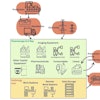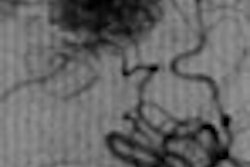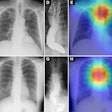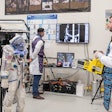
Radiography's migration to filmless imaging is in full swing, with computed radiography (CR) a well-established technology and digital radiography (DR) making significant inroads in the past several years. But as many facilities convert to digital x-ray, they are discovering that CR and DR are far more than just digital versions of analog radiography.
CR and DR should be handled in very different ways from conventional x-ray. Film-based techniques that were common in the past will not work when using filmless systems. There can even be negative aspects to CR and DR conversion, such as higher retake rates and the phenomenon of "dose creep," in which radiation dose delivered to patients begins rising following conversion to digital. Some articles have even gone so far as to note the "dark side" to digital x-ray.
What is important to know is that fundamental differences exist between film and digital imaging, and understanding these differences is the key to great digital imaging. This article points out some of the more significant differences, and describes how adjustments to technique can help facilities vanquish the dark side of digital x-ray before it even rears its ugly head.
Film density
Exposure is defined as intensity multiplied by time (I x T, or mAs). Since the first x-ray generator/tube was created, changing mAs changes density on film -- if you increase mAs, density increases. If you decrease mAs, density decreases.
Film has a characteristic curve (the Hurter-Driffield curve), a nonlinear response to exposure. DR and CR have a linear response to exposure. DR/CR density will not change as exposure (mAs) is changed. Changing exposure changes signal-to-noise ratio -- low mAs creates inadequate photons into the detector, resulting in noisy (grainy) images. Increased exposure produces better signal to noise and smoother, lower-noise images. This improvement also leads to potential for overexposure, dose creep, and higher retakes.
Subject contrast, dynamic range, and resolution
Low kV produces high subject contrast, while high kV produces long-scale contrast on film. This is not totally correct with digital. Higher kV may be selected without decreasing subject contrast using filmless imaging.
Compared to film, CR and DR have a much greater dynamic range, but lower spatial resolution. The spatial resolution of CR/DR systems range from approximately 2.4 line pairs per millimeter (lp/mm) to 4.6 lp/mm, while film systems range from 10 lp/mm in general radiography imaging to 21 lp/mm for film-screen mammography.
However, filmless images look better than film. The increased dynamic range of CR creates superior contrast resolution, enhancing the edge differences of anatomical structures. DR systems typically have greater contrast resolution compared to both film and CR. Achieving a similar image "look" from film to CR or CR to DR will be difficult and probably not realistic. The greater dynamic range advantage of CR/DR does not mean more forgiving exposures, but rather more room for exposure error, noise, and overexposure.
Understanding dose creep
The common practice in analog film-screen radiography for decades has been to image at a film speed of 300 or 400, but thinking in terms of film speed is not a good idea with digital imaging. The equivalent film speed of CR and DR could be 400 speed, or it could be 1,000 speed or 100 speed, depending on the department's acceptance of noise (and dose).
Typically, noise "destroys" structure edges. We tend to overexpose with CR/DR to smooth out the image. Because noise is objectionable, mAs is often increased to reduce it (density does not change).
Most manufacturers' exposure values or index systems used to ensure the proper exposure range for select exams vary widely -- for example, a skull exam could have a suggested range of 100 to 400 exposure value. That is a 4X spread in exposure, 400 using less exposure resulting in more image noise versus 100, which results in a smoother image but higher dose. Some of these values put dose levels equal to where we were 30 years ago, before rare-earth phosphor technology.
Differences within filmless detectors can have a direct influence on dose efficiency, which varies among manufacturers. Pixel size, quantity of pixels, pixel fill factor, the active area of each detector pixel, and image processing software produce different levels of exposure efficiency from company to company. CR phosphor-packing density, crystal size, structure, and software produce different dose efficiencies with CR manufacturers. Some universal standards are needed.
Is digital more forgiving?
Many techniques and tricks commonly used in the film world for decades will likely cause image quality problems with digital systems.
With film imaging, we vary mAs when changing density -- adjust the automatic exposure control (AEC). Unfortunately, kV is also used to change density. The term "phototimer" should direct us to vary mAs with a fixed kV and allow the AEC to do what it is intended to do -- adjust exposure/density. Positioning skills with the body part and collimation positioning are always key with film. Those key skills are even more critical with digital.
Multiple images of an extremity are common on a single sheet of film to save film consumption. However, we are not using or wasting film with digital, and putting multiple images captured digitally on a single CR/DR plate will likely create low-contrast images compared to film.
Scatter, off-focus radiation, a poorly collimated image, or a poorly positioned body part on film produce a few silver crystals developed outside the anatomy on the image. With digital, all the extra radiation in the x-ray signal striking the detector, excess scatter, excess radiation outside the collimator field, lack of lead masking, and other factors become part of the digital image histogram. The result is poor image quality. In this area, film was clearly more forgiving. Severe overexposure with CR/DR typically produces flat low contrast.
Conclusion
A few simple things will help make a filmless conversion pleasant and rewarding while providing superior image quality compared to the "good ol' days" of film. With digital imaging, old film habits will probably result in suboptimal digital images -- good to great attention must be paid to exposure conditions with filmless systems.
A few key points should be kept in mind:
- Use rubberized lead masking to shield unused areas (outside the region of interest) of a detector.
- Encourage great collimation on all images.
- Practice superior positioning skills.
- Use mAs to control noise/dose.
- Stay near the upper end of any exposure value system (higher number) while maintaining reasonable levels of noise.
- When in doubt, don't go it alone, and don't think film. Contact your manufacturer's representatives for assistance.
Quality control will be somewhat challenging until our industry establishes some kind of national uniform standard for filmless imaging. CR and DR systems from different manufacturer vary widely in exposure optimization, exposure recommendations, and image quality parameters. Limiting variables that we can control onsite will dramatically help in both areas.
This author is an old film manufacturer's representative from over 30 years ago, and would not go back to film! It's a very good digital world, if we use it intelligently.
By Robert Meisch
AuntMinnie.com contributing writer
May 14, 2007
Robert Meisch is an imaging consultant with area of emphasis in digital radiography, computed radiography, digital solutions, and mammography. He can be reached at [email protected] or 330-418-5539.
Related Reading
CR/DR image quality: Issues and concerns, April 12, 2007
Strategies for reducing 'dose creep' in digital x-ray, April 11, 2007
Study suggests ways to cut CR radiation, March 5, 2007
Korean rads find no edge for high-res CR in chest exams, January 22, 2007
Study: DR delivers lower radiation dose, November 7, 2006
Copyright © 2007 AuntMinnie.com



















